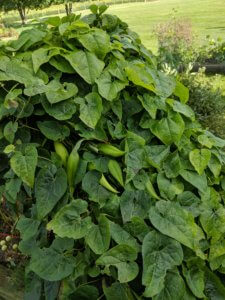Honeyvine – a native plant that can be both friend and foe.
November 5, 2019

Honeyvine is a native plant that benefits pollinators but can be weedy.
Photo Credit: W.B. via email
Q: This vine has perennially volunteered in my garden for a few years now. I let it grow because it seemed to please the butterflies, and the small white flowers smelled nice. At present it has grown chartreuse seed pods. Can you tell me what this vine is? Is it something I should destroy? – W.B.
A: Ah, beauty and function are in the eye of the beholder. I believe your plant is what is commonly called honeyvine, sometimes called bluevine. The current official botanical name, Cynanchum laeve, has been reclassified numerous times over the years so may be listed under several other botanical names, depending on the reference.
Honeyvine is in the milkweed family and is native to much of the eastern U.S. It can have a weedy habit due to the aggressive twining stems and ability to spread by seed. The small, fragrant flowers occur in clusters and are followed by large pod-like fruits that are filled with hairy seeds, typical of the milkweed family. As those hairy seeds are released, they spread easily in the wind and so often show up as volunteers in unexpected places. On the plus side, honeyvine is a great resource for many pollinators.
Additional information on this plant can be found at USDA Natural Resources Conservation Service and Illinois Wildflowers.